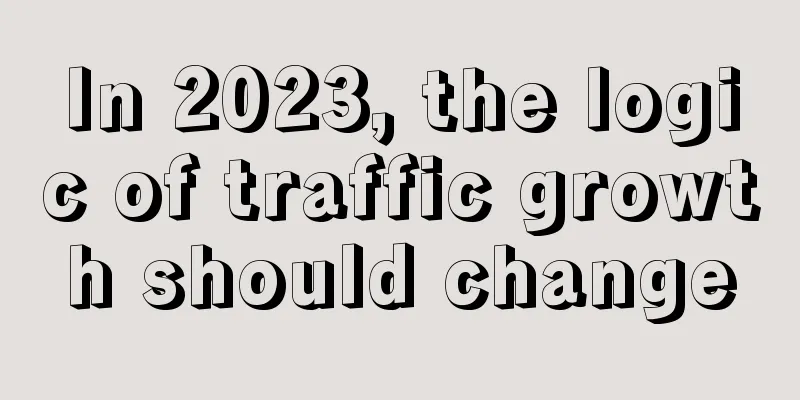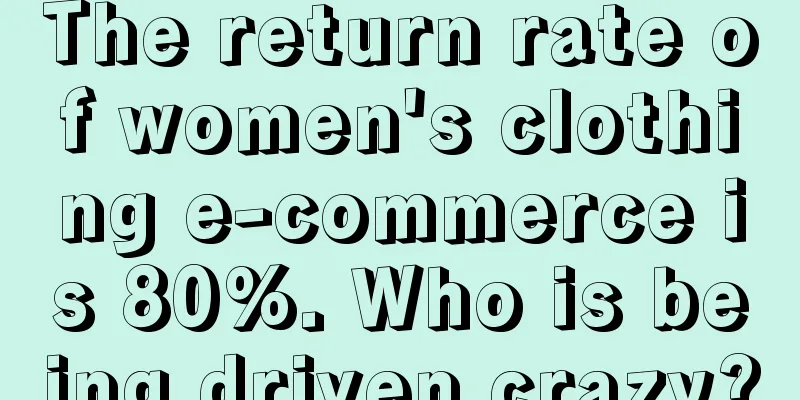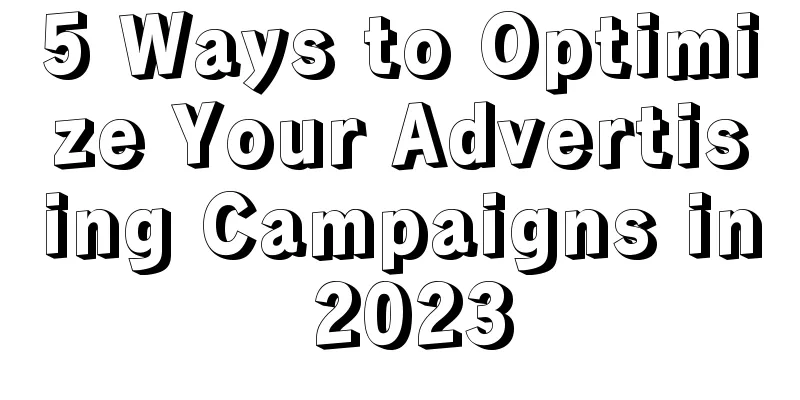In 2023, the logic of traffic growth should change

01First of all, I hope to reach a consensus with everyone: thinking determines behavior, and behavior determines results. Bill, founder of Bishop Information Group, wrote a business classic called How to Sell Lobsters. In the book, he told such a story. Bowden, chairman of Gleaming Great Lakes Cement Company, complained to him that global cement prices were falling every day and there was a surplus of cement in the market. If this situation continued, they would have to lay off employees and close some factories. During the conversation, Bill felt that Bowden and his company were trapped in some kind of product trap, so he asked, have you ever thought about developing some new products, some products that can make more money and get out of the predicament? The other party said that he spent some time thinking about the problem and trying to find some new ideas, but in the end he found nothing. At the end of the discussion, a key issue came up, which is price. Bowden believes that the business is obvious here, and no one will be willing to buy a bag of cement for more than $4, which is the standard price in the market. "I think we are completely restricted by it." Later, Bill asked his father's friend Uncle Mike about this problem. After the two sat down in Starbucks, Uncle Mike said, "Bowden and his team were stuck in a fixed incremental mindset. They thought no one would pay more than $4 for a bag of cement, so they couldn't think of anything new to try with users." But what can be done? $4 a bag of cement is indeed a common practice in the industry. Uncle Mike went on to say that in the early 1990s, the average price of a cup of coffee on the market was 50 cents, but did you know that Starbucks' leaders had a vision to sell coffee for $5 a cup? At the time, this idea was absurd in the industry. How did Starbucks do it? They wrote a price of $5 on the mug. Once you hold a mug like that in your hand with a high price on it, you start to think: What do we need to put in this mug to make this price worthwhile for the user? This process will open your mind and force you to think big; this method will break your incremental mental model. Finally, Starbucks used packaging to completely differentiate itself from its competitors. They realized that in order to make people happy to spend $5 on a cup of coffee, they needed to create a completely different consumer experience and provide something better and beyond the norm. For example, the cafe is decorated very comfortably and elegantly, with leather sofas and a roaring fireplace. They offer dozens of high-quality coffees for you to choose from, and they only take a few minutes to prepare after you place your order. You see, if you change your mindset, brand growth becomes clear. 02The problem facing brand marketing today is that it is restricted by an industry standard. That's traffic. Two or three years ago, social media platforms such as Douyin, Xiaohongshu, and Bilibili formed a traffic depression. Brands that took the lead in speaking out on these platforms, such as Perfect Diary, Wang Baobao, and Ubras, achieved maximum communication effects at extremely low traffic costs. It was said that the average ROI at that time could reach 1:10 or even 1:15. But starting in 2021, a large number of emerging brands saw the opportunity and flocked to Douyin and Xiaohongshu at the same time, and the traffic depression was quickly squeezed into a red ocean. In the first quarter of that year, many brand owners complained to me that their ROI dropped painfully. Nowadays, an ROI of 1:1.5 is already very good. This is not the biggest problem. What is more annoying is that the high cost of attracting customers does not actually bring ideal returns. First of all, the efficiency of user repurchase and bringing in new customers is low. Behind this problem is actually the problem of product homogeneity. Currently, most brands focus on the marketing end, while product research and development and even the entire supply chain construction are placed on mature processing plants. What is the problem? Multiple brands rely on the stock of a few processing plants, resulting in a large number of similar products flowing into the market. They are no different in function and quality, but just have different LOGO labels. When these brands are promoting online customer acquisition, users' choices are flexible. They do not have much stickiness to products of a similar brand, and of course there is not much word-of-mouth fission. Secondly, the brand’s multi-category products are not able to better absorb customer flow. This is directly related to the spread of new media channels, especially Douyin and Kuaishou, whose recommendation mechanism pushes information based on personalized interests, that is, interest-based e-commerce. Brands will create diverse content to promote their products based on different interests and scenarios. Users may be attracted by the content and pay for it in such scenarios. But he is not buying the brand, but the individual product itself. For example, after a beauty brand uses lipstick to do hobby e-commerce, it is actually difficult for its other products such as eye makeup and skin care products to gain monetization from this wave of traffic. Unless, the brand creates new interest content based on eye makeup to reach interested groups. In addition, more brands do not have enough SKUs to alleviate user churn. When people buy your product out of casual interest or the impulse of "trying something new", but you do not have more other differentiated new products to reach users in the long term, this wave of user churn will occur. As a result, brands need to continuously acquire customers at high costs and constantly accept the fact that the return on customer acquisition is low. Ultimately, brands are working for media platforms and KOLs. 03The current traffic problems are actually self-limitations caused by rigid thinking patterns. Long before the epidemic, I attended a down-to-earth entrepreneurship salon in Wanzhou, a county in Chongqing. During this salon discussion, two different ways of thinking collided and sparked sparks. The first one can be summarized as: rent is advertising fee. This view was put forward by a university dropout who started by joining a real estate agency and subsequently invested in businesses such as milk tea shops, coffee shops, teahouses, massage and foot washing. When investing across industries, this boss has a unified business rule, which is that the store location must be good. Take one of the milk tea shops as an example. He opened the store in a suburban shopping center, which is a major transportation artery in the urban-rural fringe. The business district radius is expected to cover 30 kilometers, with more than 500 parking spaces. According to preliminary estimates, the daily traffic of such a shopping mall can exceed 200,000 people. His business logic is simple: if 200,000 people flow into the shopping mall every day, 100,000 people will come to the store area, 50,000 people will notice its existence, 5,000 people will have a desire to buy, 500 people will walk into the store, and finally 200 people will place an order. There is no need to go into detail about the specific data, the logic is roughly this. In this case, the store rent is the advertising fee paid for the 100,000 impressions. As long as there is a conversion rate of 0.02%, the store will not lose money. But doing business is a dynamic process. If you don’t lose money now, what about in the future? This store is now facing some problems: the rent of shopping malls is on the rise; nearly 10 similar milk tea shops have opened in the same shopping mall; and the salaries of the two store managers are also promised to increase by a certain percentage every year. Variable costs are increasing, conversion rates are being diluted by other milk tea shops, and the logic that rent is equal to advertising fees seems to be untenable. The second way of thinking is roughly: choosing a location is actually choosing a circle of friends. The first person to put forward this view was the owner of a chain of more than 30 restaurants. For example, his third restaurant was opened next to a government agency. Within one month of opening, he invited dozens of officials to dine in the restaurant with his local connections. They are the seed users of this restaurant. The boss said that as long as he serves these people well, they will think of this restaurant first whether they invite others to dinner or others invite him to dinner. This is called the fission of seed users. If the new users brought by the seed users also find the service good, they may bring more users. This is the second fission, which is called "three waves superposition" in the Internet. Although this model is subject to market contingency, it is not only found in the restaurant industry. Many years ago, every time liquor entered a new market, the focus was on winning over local consumer leaders such as government officials, which the industry called the "plate within a plate model." The development of the Internet has resulted in more categories of “Pan in Pan” marketing targets, most of whom are KOLs and KOCs in this field. Bi Sheng, the founder of Bixi Mall, also discussed these two thinking modes in his new book "Traffic is the Blue Ocean". He divided them into the traffic funnel model and the traffic ladder model. The traffic funnel model focuses on conversion, which corresponds to ROI; the traffic trapezoidal model focuses on fission, which corresponds to LTV. 04Judging from the new consumption wave, most brands currently still use the ROI approach, looking for bloggers on Xiaohongshu, anchors on Douyin, and then selling products through traffic delivery. But the discussion about LTV started around 2015. We said at the time that the increase in customer acquisition costs means the increase in the value of each customer. It seems urgent to privatize user assets and tap into the value of each user. User resources are already in stock, and the traditional business strategy of competing for sales with each user is no longer applicable. The way out for brands is to increase users' single large-amount consumption or frequent repurchases, and to enable old users to bring in new users. At that time, Meituan’s Wang Xing also said, “The number of users cannot double again, but the value that users can create (ARPU) has far more than room to double.” The shift from traffic management to user management has become an obvious one. It was not until a long time later that this kind of gameplay was named: private domain . But the current private domain gameplay is mostly to pull users into a WeChat group. Fundamentally speaking, pulling a WeChat group just makes the user private. For example, before, you couldn’t do anything to guide a user to come back after he/she shopped in your store. But now, you can use new products to run an event, issue some fission coupons, or even do some in-app purchase promotions regularly… You can actively reach users, this is the private domain, but this is not private domain operation. Real private domain operations should focus on at least three aspects: average order value, repurchase rate, and conversion rate. Average order valueRecently, I investigated a light beauty brand "Miao Shiqi", whose main business is a face wash bar. In the market, the average customer price of a face wash bar is mostly around 80 yuan, but this brand can do it up to 129 yuan. Through private domains, the brand often initiates discussions in groups. Based on seasonal issues reported by users and population segments with appropriate granularity, the brand packages the original single services into personalized packages. These package services were first tested in private domains and then promoted to the national market. In this way, the average customer price was more than 50% higher than that of its peers. The operation of average order value is actually a question of product structure and product combination. The private domain provides brands with an unprecedented opportunity, which is to proactively reach the real needs of users and thus configure a product structure that truly meets market demand. Repurchase rateWhen discussing how to increase the repurchase rate, the RFM model is generally proposed, namely the most recent consumption (Recency), consumption frequency (Frequency), and consumption amount (Monetary). Karmaloop, an American trendy brand e-commerce company, is a classic example. Through these three data points, Karmaloop selected high-value users who made multiple repurchases, spent a lot, and rarely returned products. This group of people only accounted for 1.3% of the visits, but contributed 43% of the revenue. In summarizing the common behaviors of these high-value users, Karmaloop found that in 80% of cases, a user would place an order twice and complete the second order within 30 days of the first order. This means that most low-value users will not make repeat purchases within a 30-day period. In other words, if a user places an order and does not place a second order within the next 30 days, it is increasingly unlikely that they will become a high-value user. However, if they place an order within 30 days (which is in line with ideal user behavior), they have a great chance of becoming a high-value user. In other words, Karmaloop needs to guide users to repurchase within 30 days in order to convert more and more high-value users. At this time, Karmaloop came up with two solutions:
In daily operations, Dulu no longer issues coupons to users who consume within 30 days. When the period exceeds 30 days, different levels of discounts will be issued according to the interval period. Specifically, within 30 days of the user's first consumption, the original-priced goods will be pushed to them as information interaction on a daily basis; if there is no repeat purchase after 30 days, a 10% discount coupon will be pushed to them; if there is no repeat purchase after 45 days, an 20% discount coupon will be pushed to them; if there is no repeat purchase after 60 days, a 30% discount coupon will be pushed to them. Once the user makes a repeat purchase at a certain stage, the entire operating mechanism will return to the starting point. Conversion rateThe conversion rate here is no longer the conversion rate of user influence/user order. The purpose of private domain is to increase the frequency of user repurchase, thereby continuously diluting the initial customer acquisition cost and achieving a high order conversion rate. So, what kind of conversion rate does the private domain need to test? In fact, it is the efficiency of old users helping you convert new users. In traditional business, products and services are the only way for old users to introduce new users to you. But in the private domain, we can guide old users to refer new users through more ways. For the same face wash bar "Miao Shiqi", when the number of members in the store community reaches a certain number, the membership system will automatically trigger a fission tool, which is actually to issue 6 friends and family coupons specially for members. What does it mean? You can’t use this friend and family voucher yourself, but you can give it to your bestie, colleague, etc. 6 is also a magical number. Stanley Milgram, a famous American social psychologist, once conducted a psychology experiment that proved that it only takes 6 people on average to connect any two Americans. Later, this experiment developed into the "six degrees of connection" theory, which means that theoretically you can get to know any stranger through at most six people. In the end, through 6 friends and family coupons, the number of "Miao Shiqi" members showed exponential growth, with the increase in new members reaching 166%, a year-on-year growth rate of 331.7%. And 50% of these members consume 2-5 times per month. 05In fact, many brands are doing private domain, but they are more sensitive to "operating users" and "managing users". They believe that traffic can be precisely divided, and that is called management. However, users are real people, and when they hear that they are being managed by brands, they may feel disgusted. So at the operational level, brands are more exploring what new technologies and methods can help us do our job better? But in a world full of uncertainty, ambiguity, and fierce competition, they find that the more important question to ask is: What do users need? How should I respond? The uncertainty that managers worry about most often comes from the market. The market obviously exists, and no one can escape it. The fate of all business organizations will eventually be determined in the ruthless operation of the market. However, we have neglected the understanding and knowledge of the market. Many managers have not really tried to understand the market, nor have they really cared about users. In essence, the purpose of a brand is to attract and retain users. If a brand cannot attract a certain number of users with purchasing power, it will not survive. above. Author: Huang Xiaojun; Official Account: Jingyan Brand Lab (ID: JingyanLab) |
Recommend
Can I return items purchased from eBay without any conditions?
eBay online shopping inevitably involves the issue...
Can Shopee change its discounts? How to set prices correctly?
When opening a store on different e-commerce platf...
Xiaohongshu, the most suitable platform for Chinese lululemon from 0 to 1
With consumption upgrading and increasing personal...
Why do reaction videos become popular when foreigners listen to Chinese music?
As reaction videos become more popular, people can...
Successful transformation! Domestic trade OEM has become the leader of Shopee
China's domestic trade market is full of volat...
What is the difference between graduating and not graduating from Shopee? What are the impacts?
The Shopee platform has a new store incubation per...
What are the top ten cross-border e-commerce platforms? Share the top ten cross-border e-commerce platforms
The rapid development of cross-border e-commerce h...
Takeaway lockers have started charging deliverymen, are they crazy?
This is the 1367th original article by Half Buddha...
How to improve private domain conversion rate?
This article finds that many companies and busines...
What should I do if there are only 50 or so visitors on AliExpress? How can I increase visitors on AliExpress?
Having an AliExpress store but only getting 50+ vi...
How to update the attributes and categories of global products on Shopee? How to perform batch operations?
The Shopee Store Product Attribute Tool is a produ...
How much is the entry fee for shein cross-border e-commerce platform?
The entry threshold of Shein cross-border e-commer...
With subsidies and traffic, Douyin and Kuaishou have increased their graphic and text content. Are new opportunities coming?
The promotion of goods with pictures and texts is ...
Where can I find Amazon's conversion rate? How can I increase Amazon's conversion rate?
The conversion rate of a store is an important fac...
How to operate a Shopee store? Introduction to Shopee store operation
Nowadays, many friends are engaged in cross-border...









